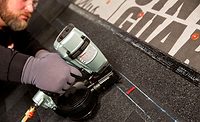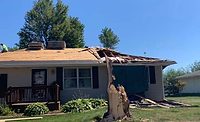How Roofing Contractors Can Improve Homes with FORTIFIED Roofs
With extreme weather on the rise, learn how to build stronger roofs with the FORTIFIED method

Photo: IBHS.
More homeowners nationwide are seeking ways to make their roofs stand up to the harshest weather, giving roofing contractors a chance to become heroes.
The Insurance Institute for Business & Home Safety [IBHS] recently celebrated a milestone of having 50,000 roofs designated as “FORTIFIED.” A specific designation established in 2010, the FORTIFIED program is a roofing methodology based on decades of research that improves the longevity of a roof against hurricane-force winds and severe storms.
“We are turning the tide and seeing a marked shift, with more than half of all FORTIFIED designations being earned in the last three years,” said Roy Wright, president and CEO of IBHS. “Yet, there is more work to do, especially in areas without modern building codes where it falls on the individual homeowner to lean in and take the lead on resilience.”
There are three aspects involved in a FORTIFIED roof:
- Nailing. Properly nailing down roof decks is the first step. Building codes are catching up, but FORTIFIED suggests nailing above and beyond standard codes.
- Sealing. FORTIFIED requires sealing the roof deck and using the right sealing system based on the roof type (e.g. shingles versus cedar shakes).
- Shoring up the edges. IBHS’s research shows roofs experience the highest pressures at the edges and offers guidance on strengthening aspects like the eve, the rake, hips and ridges.
It can cost a homeowner between $1,500-$2,000 more for a FORTIFIED roof, but there is help. States like Alabama and North Carolina have government-sponsored grant programs providing homeowners funding to pay for a FORTIFIED roof. Mississippi, Louisiana, Oklahoma and North Carolina offer wind mitigation incentives for properties constructed to the FORTIFIED standard.
Minnesota lawmakers are considering legislation to establish a grant program, and Louisiana officials have indicated they’ll seek $20 million for funding a Fortify Homes grant program this year.
This increased demand for stronger roofs, combined with more states jumping on board, allows roofing contractors to stand out from their competition.
“It's driving opportunity for roofers in places like Louisiana, in other Gulf Coast states — we’re even beginning to reach inland in places like upstate Alabama, Kentucky, Minnesota, Iowa — places like that,” said Fred Malik, managing director of IBHS’s FORTIFIED program.
Roofing contractors can visit fortifiedwise.com for training on the roofing methods and familiarize themselves with the process. They can become FORTIFIED Certified through online training offered by IBHS. It isn’t limited to residential, either – IBHS has FORTIFIED solutions for commercial and multi-family projects.
“Folks are going to be really paying attention to the wind durability of their roof, not just in hurricane-prone areas, but everywhere,” Malik said. “I think that roofers have a real opportunity to recognize that this trend is coming, [to be] involved with a program like FORTIFIED, take advantage of our training.”
IBHS isn’t ignorant of the supply chain issues that could cause homeowners to hesitate on paying more for a roof when prices are already volatile. Malik said roofers can alleviate this by requesting the products they need from their suppliers.
“One of the best influencers in that space is the roofers telling their suppliers, ‘Hey, I am putting on a FORTIFIED roof; what do you carry that can help me do that?’ That reinforces with the suppliers, ‘Hey, this is something I need to pay attention to,’” he said.
Looking for a reprint of this article?
From high-res PDFs to custom plaques, order your copy today!






